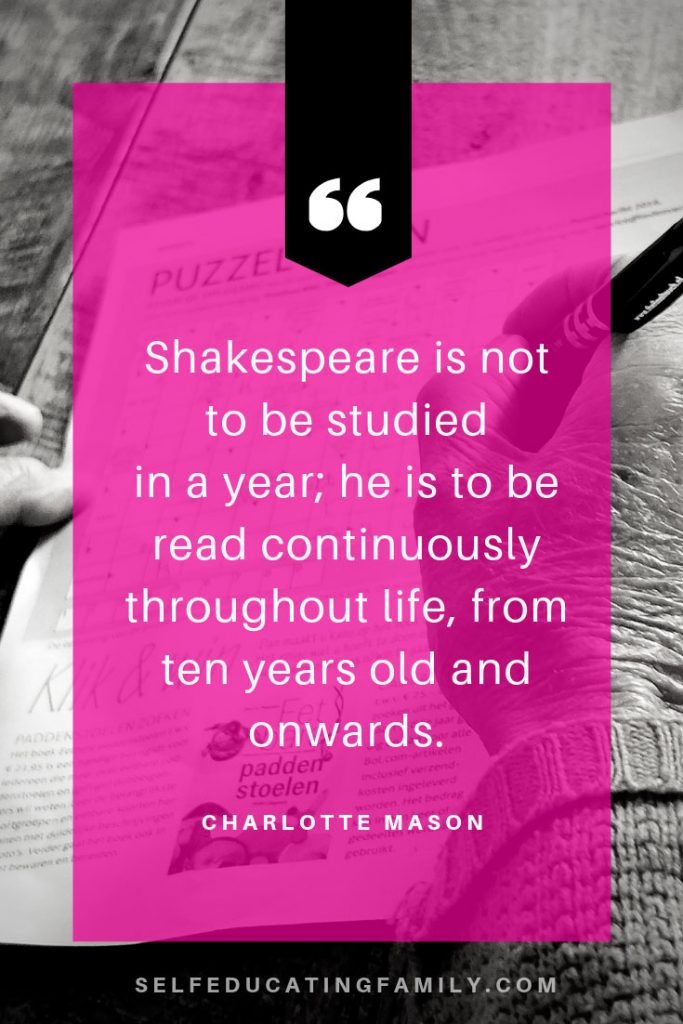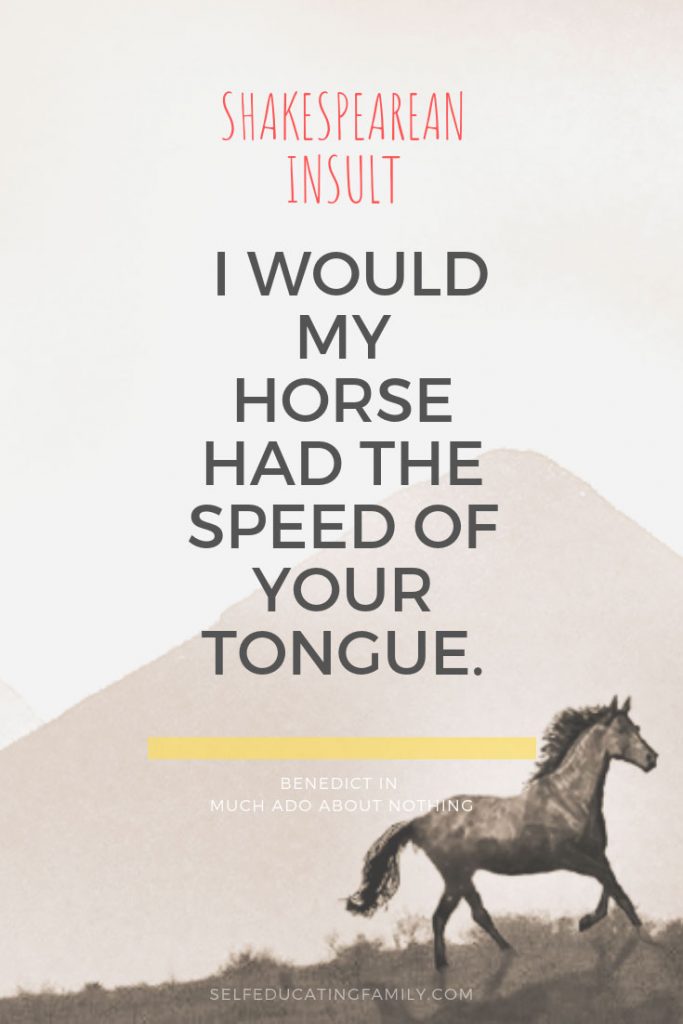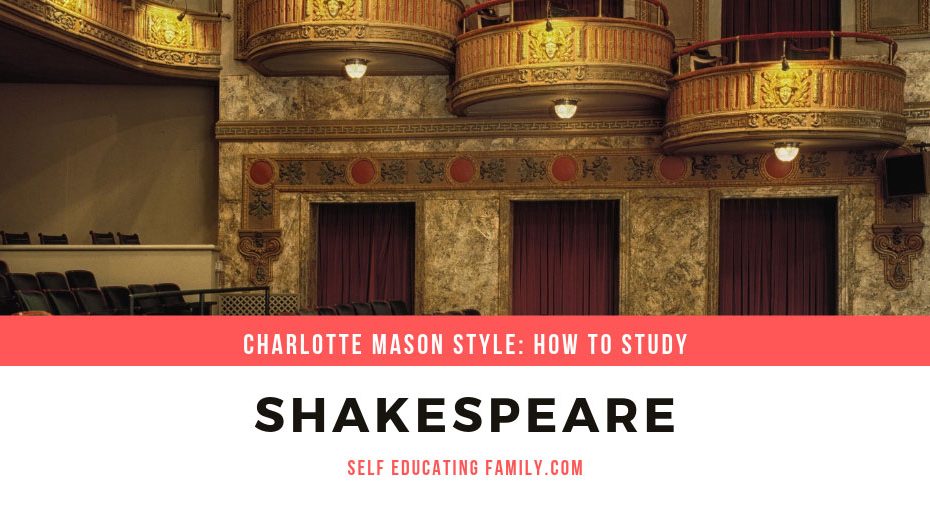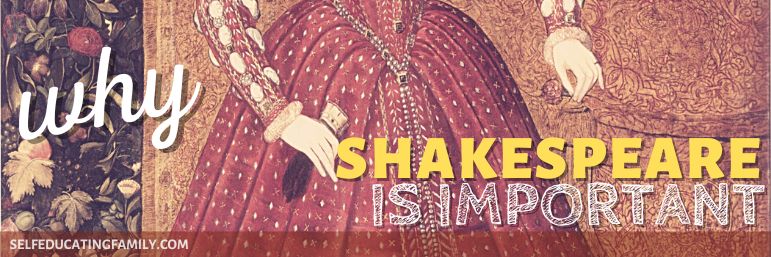What’s inside: Charlotte Mason (CM) included Shakespeare as a part of a child’s well-rounded education back in the 1900’s. But how should you study Shakespeare? Is it still relevant today?
How to Study Shakespeare
I have no idea what high schools do today, but my high school years ago required one Shakespeare play a year: Romeo & Juliet, Macbeth, Midsummer’s Night, & Hamlet.
Ambleside Online (AO) schedules a Shakespeare play every term in a trimester, using Lamb’s Shakespeare summaries for little ones and then the actual plays after Year 4.
My co-operative group
When I helped start a local CM co-operative group, we aimed to “do all the fabulous stuff CM recommends and we want to get to but never have time.” In other words, a bunch of moms formed an accountability group to get to all the fun stuff we wanted to do regularly that we felt was super important, but somehow got put at the end of the list and really couldn’t take precedence over Math or History.
We originally included Shakespeare, Recitation, Handicraft, Poetry, Artist & Composer Studies, and Nature Study and had about 18 kids and 5 moms. Each mom took one or two of the topics and led the kids. We made many changes over the years – adding some subjects, removing others, changing who led what and how we led – but one thing was constant. We always have done Shakespeare together.
Which Shakespeare plays?
Because we did two or three plays together each year, by the time my two oldest sons completed high school this past year, my sons have read, analyzed, and sometimes even play acted 15 of Shakespeare’s 37+plays, including:
- Hamlet
- Midsummer’s Night Dream
- Richard II, Henry IV Parts 1 and 2, and Henry V
- Henry VI Parts 1 and 2, and Richard III
- Taming of the Shrew
- The Winter’s Tale
- Macbeth
- Comedy of Errors
- Much Ado about Nothing
- The Tempest
My youngest son is still going, so he will have probably six to nine more added to that list.
Our CM group generally follows the AO recommended schedule, but some years we have changed due to various circumstances. For instance, for my sons’ senior year, we noticed they never read Macbeth. We definitely needed to include that one. We’ll have to switch next year up also since that’s when Macbeth was scheduled and we will have another senior next year, so we’ll substitute something she hasn’t read that’s on her “do not skip” list. Probably one of the comedies – we are due for some. Maybe Twelfth Night or Measure for Measure.
Our Methods

Our group follows Charlotte Mason methods of teaching which rely on the practice of narration for the student to make the material their own. My co-operative group is fortunate enough to have an outstanding leader who not only has studied Shakespeare but who has mastered guiding narration in group settings.
Group Narration
CM herself worked with kids in a school setting, so the concept of group narration is not novel. It just takes practice. The hardest part is letting each student wrestle with the material. Simply using open-ended questions is a skill to master for group narration. And balancing the conversation by allowing each of the children to have their say.
That’s why we are so fortunate to have a skillful leader – but she’s gotten there through practice.
Teachers learn while students learn
Each semester we review what worked and what didn’t.
On the “didn’t” side, our largest mistake early on was doing too much for the kids. Giving too much structure or asking too many guided questions didn’t work for us. So we started avoiding questions like, “Does Hamlet have a problem with his uncle?” and switched to questions like “What do you think about the characters in Hamlet? How can we describe them? Does their character change at all throughout the play?”
We often actually keep a running chart of characters and what they are like that the kids add to each session.
While our methods have evolved over time by reviewing what went well and what needs tweaking each term, we have settled into a pattern of instruction. We typically have 6 or 7 sessions together, with the bulk of the reading and narration done independently at home. When we get together we will review the Act by having the students tell back what happened in each scene. Then each student will share their favorite quotes or sections, and then we will read a few scenes together and narrate those. At the end of the semester, we will do some kind of “giant” narration about the whole play. Sometimes, we will watch a movie or live version together at the end of our studies.
Reading vs. Watching
Each family in our co-operative reads the play on their own schedule throughout the term. While I generally prefer to read a book before watching the movie version, I like doing Shakespeare the opposite way. My family almost always watches a version of the play FIRST, and then reads and listens to the play act by act. I am a great believer in the notion that a play should be seen rather than read. It’s a play, after all. While Shakespeare is a master wordsmith, he was writing for the stage.
Choosing a version to watch
So I will research the movie versions available to find the most appropriate, then get it from the library to watch together. My criterion for “most appropriate” generally involves a critically acclaimed version that doesn’t veer too much off the original setting or language. Each family will be different, so if you watch a film version, make sure you get one that does the play justice*, and has the right maturity level for your family.
*Some directors like to put their mark on Shakespeare’s plays by using crazy interpretations on both the stage and screen. I usually feel like most can’t pull off changing the time or place setting.
Though some adaptations do work, I have to admit. Like Joss Whedon’s Much Ado About Nothing (2012), a black and white film that is set in modern clothing and filmed actually in his own house over 12 days. It uses Shakespeare’s language and adds some filmed innuendo about the relationships (strong PG-13 rating, not really for kids), but sticks largely to the story, and the film works. It’s very well done. Though I actually prefer Branaugh’s traditional version, especially the music that’s woven throughout. Branaugh’s film really nails the Shakespearean atmosphere despite being produced on film, rather than on a stage. It’s also PG-13, but slightly less explicit than Whedon’s film.
Most of the better film renditions of any of Shakespeare’s works tend to get more mature ratings. Although I have to confess, I really like Gnomeo & Juliet (G) despite the complete story setting and ending changes!
How can I find a good movie version?
For a run-down on movie versions of the various Shakespeare plays, I recommend checking Kids-in-Mind or Commonsense Media for the newer films. Linda over at Charlotte Mason Help has some detailed recommendations that can be useful for some of the older film versions.
Shakespeare always wrote for distinct aspects of the crowd. He always threw in comic bawdiness for the rabble in the cheap seats and he always included lofty themes for the nobility. It’s probably why his plays have lasted so long – a little something for everyone. But every director always tells the story that they want to tell.
Anyway, pre-screen any video version to make sure it fits your family.
Reading first or watching first?
Our family watches first then we read it together, aloud, after seeing the whole play. No one else does it this way in my co-operative group – it just works best for us.
I usually get a copy of the No Fear version of the play – it has Shakespearean English on one side and regular English translation on the other, so it can be useful in making sure you understand what is being said. We more often than not will listen together to the Librivox or Archangel audio version of the play while reading along with it.
On the plus side, this method gives a feel for the whole play as intended. I’ve noticed that my kids’ narrations have improved in our group setting when they’ve seen the play first. But on the negative side, reading the play after seeing it can make some minds wander – it’s definitely harder to use your full force of attention on just listening to the Shakespearean language after seeing the whole play because you think you understand everything that’s going on. And note that if you use the No Fear version, it will translate all of Shakespeare’s bawdy references that may have gone over the heads of younger students.
Most families I know follow the three-step method outlined by Simply Charlotte Mason: Read the text, listen to the text, then watch the play. And that’s after the youngest students have heard the story versions of the plays when they were little.
Our “Giant” Narrations
Once we finish analyzing all of the acts of a play, we review the play in its entirety with a “giant” narration. Narration is a form of re-telling the story and can take many forms – from simply telling back what happened, to the more creative forms of drawing a picture or acting out a story.
When my CM group presents a final narration of the whole play, it is often memorable. One of my favorite final giant re-tellings that the kids did was a “Shakespeare in the Park” version of Taming of the Shrew. The kids had costumes and worked off a script. It was unforgettable!

Another one of my favorite end-of-term play reviews actually involved my LEAST favorite Shakespeare play – The Winter’s Tale. Winter’s Tale, in my opinion, doesn’t know what it is trying to be. Is it a Tragedy? Is it a Comedy? Or is it some weird pseudo-history? Or simply a fluff piece written out of winter boredom?
All the kids felt this play was mixed in its direction. So at the end of the term, we divided the students into two groups and had them “revise” the play with two different endings – one group had to make it a true tragedy by getting rid of the semi-happy ending, and the other group had to make it into a true comedy with lots more comic moments and less death. The kids then distilled the play into the elements that fit their genre and gave a 5-minute puppet show of their version. The results were hysterical! And the students really understood the elements of the play.
Side note on “distilling the play”:
Plays have dramatic beats that are essentially the bones of the story. I’m calling this “distilling the play” when you highlight only this skeleton of the story. It leaves you with a much shorter version of the play that captures all the essential elements.
I first saw this done while in college with a “One-minute Hamlet”. Since then, I’ve seen a 30-minute Hamlet, a 5-minute Hamlet and even a 30-second Hamlet.
Distilling the play is a very effective method of analyzing a Shakespeare play.
Final thoughts
How to study Shakespeare in a group
- Find your group and a leader.
- Select a play.
- Week 1: Introduce the play, significant characters, and general themes. SparkNotes is a good resource for this.
- Weeks 2-5 homework: Finish reading the week’s act and narrate it before you meet together again.
- Weeks 2-5 when you meet together: Narrate each scene of the act you read at home. Review favorite sections or quotes from each student. Discuss plot, themes, and characters. Start the next act together by assigning parts and reading aloud.
- Week 5: Decide what style of “end of term” review you will work on. Choices could include dramatic readings, charades, acting it out, puppet shows, comic strips, a one-minute version, or watching the play together as a field trip.
Note: sometimes, you need to decide this earlier if you need more time to make costumes or prep a script. We typically keep it simple and more on the impromptu side. - Week 6: Final Narration and wrap-up.
For more specifics and a free download of a sample schedule, head over to How to Plan Shakespeare for Your Homeschool Year.
Enjoy!
I hope you found this helpful in how to study Shakespeare in a group.

To become intimate with Shakespeare in this way is a great enrichment of mind and instruction of conscience.
Charlotte Mason Ourselves, Volume 4 of the Charlotte Mason Series p 72.






